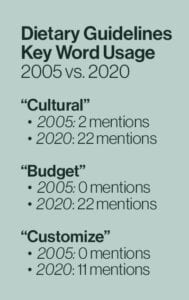In case you missed it, the U.S. Departments of Agriculture (USDA) and Health and Human Services (HHS) released the 2020-2025 Dietary Guidelines for Americans (DGAs) in the typically quiet week between Christmas and the New Year. The DGAs are critically important for food policy decisions and will shape the general guidance on consumer eating patterns for the next five years.

Media coverage focused heavily on added sugar and alcohol recommendations made by the DGA scientific advisory committee last spring that were not included in this latest version of the policy document—but there was a missed opportunity to highlight other areas from what should be considered the most progressive version of the guidelines released to date. Here are some key points that deserve greater attention.
A focus on diversity and inclusion
The 2020-2025 DGAs provide specific guidance to “customize and enjoy food and beverage choices to reflect personal preferences, cultural traditions and budgetary considerations.” Coupled with actionable examples and resources (like lists containing culturally appropriate food sources of nutrients that many Americans don’t get enough of), this is a welcome change from prescriptive advice of specific foods to eat for health. The update allows people to take the DGA framework and make it their own by selecting foods and beverages to meet their own needs and preferences.
 The conversation surrounding the need for a focus on diversity in nutrition in marketing and communications is certainly not new—the Ketchum RD team co-hosted a panel discussion with Diversify Dietetics at FNCE® 2018 about diversity in food and nutrition communications—but the DGAs substantiating and socializing it is a big moment. Diversity is reflected throughout the report—from individual foods and cultural dishes displayed to photography that reflects diversity in race, age and body size. Inclusivity is also reflected in word choice, with “cultural,” “budget” and “customize” making a strong presence in the report compared to the 2005 Dietary Guidelines (see graphic).
The conversation surrounding the need for a focus on diversity in nutrition in marketing and communications is certainly not new—the Ketchum RD team co-hosted a panel discussion with Diversify Dietetics at FNCE® 2018 about diversity in food and nutrition communications—but the DGAs substantiating and socializing it is a big moment. Diversity is reflected throughout the report—from individual foods and cultural dishes displayed to photography that reflects diversity in race, age and body size. Inclusivity is also reflected in word choice, with “cultural,” “budget” and “customize” making a strong presence in the report compared to the 2005 Dietary Guidelines (see graphic).
This newly emphasized point of view should be taken as a model for food brands, since cultural competency, along with an understanding of affordability and accessibility, is a critical component to consider before positioning foods in today’s society. In addition to the health, taste and convenience benefits of the food you are promoting, ask yourself if the words and images you use to convey these attributes represent the diversity of our country.
Nutrition guidance by life stage
Also new in this iteration of the DGAs is the life stage focus, providing age-specific nutrition guidance from birth through adulthood. A fruit or vegetable, for instance, could be shown as a purée for infants/toddlers, or for older Americans with chewing issues, swallowing concerns and sensory disruptions. Going one step further, the latter could also be positioned for chemotherapy patients with acute feeding side effects. Approximately 650,000 Americans are going through chemotherapy, and a brand that provides recipe options for them could help support their healing and recovery.
The new recommendations of the Dietary Guidelines can serve as support for evidence-based messaging relevant to the various stages of life and the different nutrient, consistency, texture, sensory and palatability needs that exist across the lifespan. Brands should take a page from this in marketing and communications.
Dietary patterns over individual foods
With the tagline “Make Every Bite Count,” the DGAs embrace the idea that it is the combination of foods and beverages over time that plays the greatest role in overall health—not one single food or eating occasion in isolation. Research shows the ongoing pattern of an individual’s eating habits has the greatest impact on their health. Moving away from single food or nutrient-based recommendations, the Guidelines encourage consumers to choose nutrient-dense foods most of the time, acknowledging the place for dessert and celebratory foods.
No matter what type of food, beverage or ingredient you market—a fruit, a vegetable, an animal or plant-based protein, a snack food, etc.—communicating how food choices come together over the course of the day or week can help Americans create a healthy eating routine. Even if your product is not inherently nutrient-dense as a stand-alone item, consider cross-marketing your food with other foods or eating occasions so that your brand can play a role in promoting an overall healthy eating pattern.
What food marketing and communications professionals can do now
- Review your recipe collection for diversity—Consider various cultural norms with respect to cuisine type, ingredients used and eating occasions. Does it provide recipe ideas to meet the nutrient and consistency needs across the lifespan?
- Examine your visual imagery—Does your recipe photography include people of all races, body types and ages? Do you have cultural variety in the tablescape and dishes used for plating your recipes? Develop a diversity design guide for all designers and content creators working on your brand, so that all future content will be developed through an inclusive lens.
- Audit your amplification partners—Review your ambassador relationships and partnerships with third-party organizations and make room for new relationships that speak to diverse audiences if you’re not already doing so. Create new ambassador guidelines—both for the selection of new partners and to inform their content creation—to emphasize diversity and inclusiveness.
- Evaluate your key messaging—Should you change your approach to expand to different age groups in light of the new DGA approach? Are your insights and calls to action relevant and inclusive of a diverse population? Are you practicing food or nutrient reductionism versus talking to how your product fits into a larger eating pattern? Utilize the recommendations across the lifespan to consider untapped target audiences.
- Consider MyPlate—If you’re not already a National Strategic Partner of MyPlate, apply to become one now. You’ll benefit by networking with other fresh food marketing boards and brands, which may provide opportunity for future partnerships that will allow you to extend the reach of your brand’s message around dietary patterns, life stages and diversity.
If you’re wondering what’s next on the horizon for food brands or need help navigating the current landscape, don’t hesitate to reach out! Ketchum’s team of multicultural marketers and nutrition experts are here to help.
Jaime Schwartz Cohen, MS, RDN also contributed to this post.



